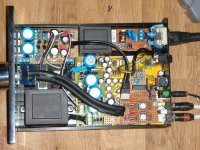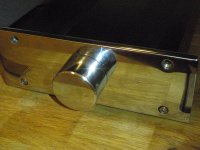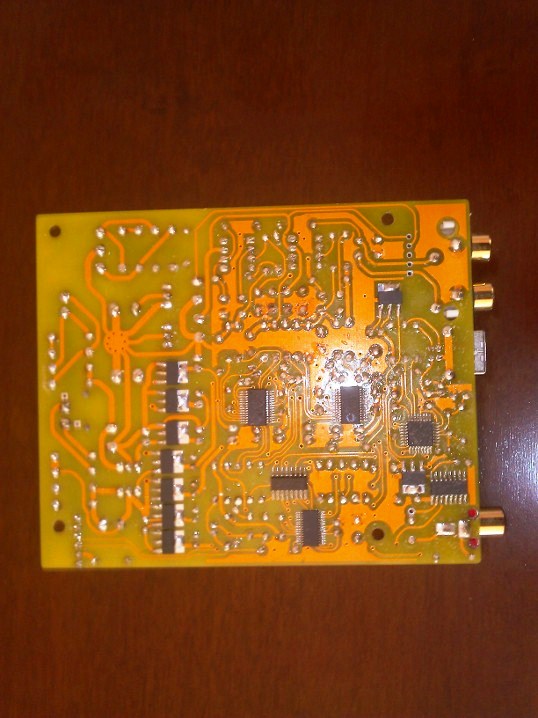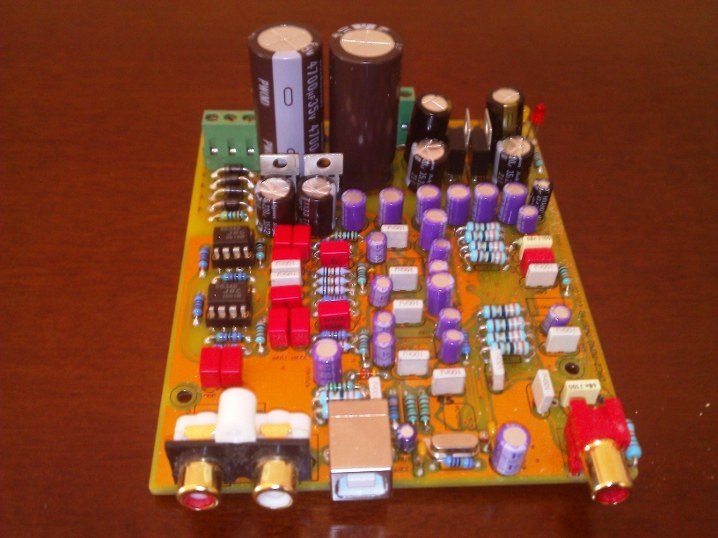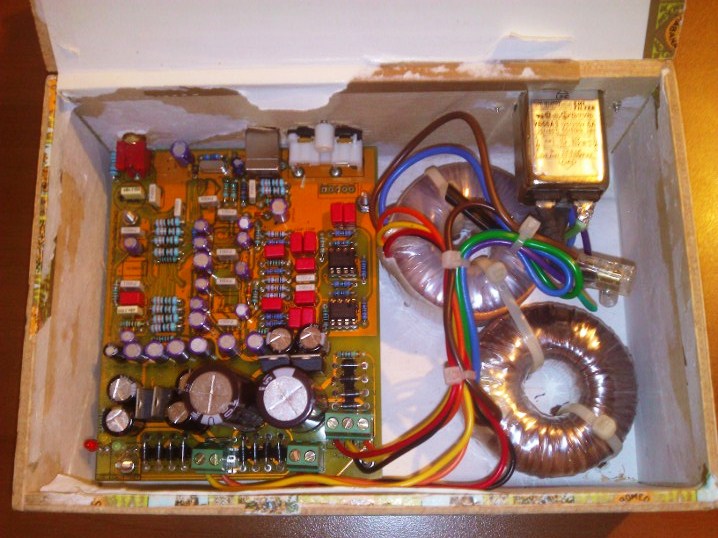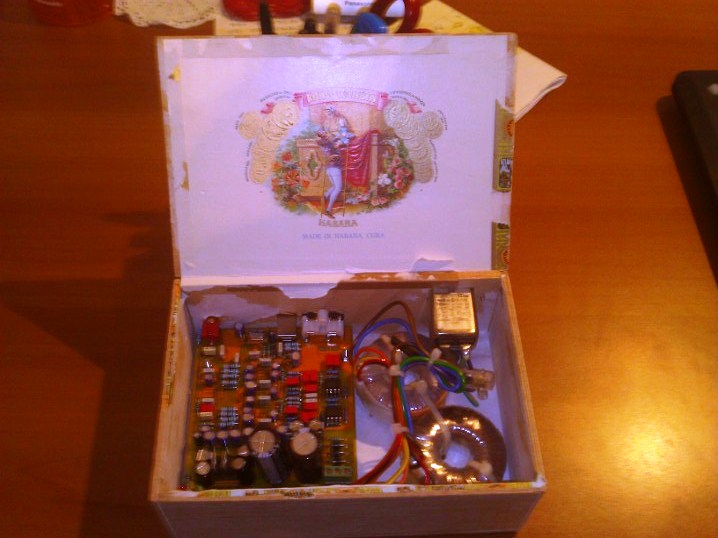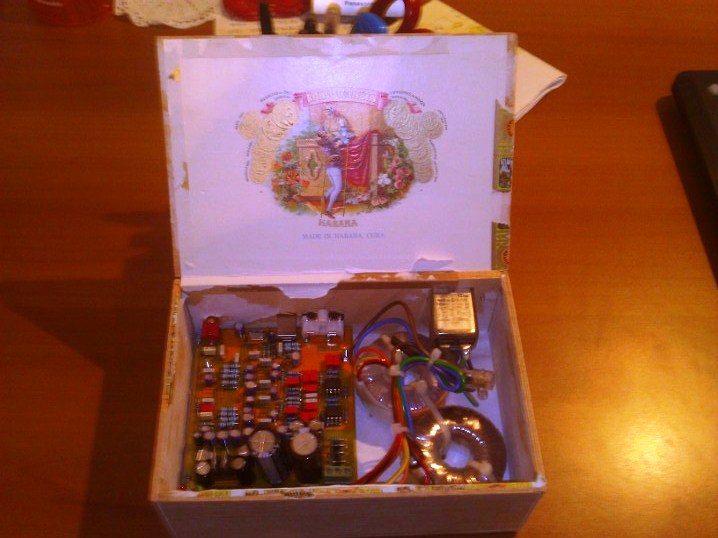On switching the clocks...
Use two separate power supplies with shutdown function to power the two oscillators.
Take the outputs of the two oscillators and feed them through two 74VHC125 tri-state buffers.
Use a control pin from (pick your source) to drive the ps and tri state enable of one oscillator, use an inverted control signal to enable ps of the second oscillator and tri state buffer enable.
Proper bypass, ferrite beads, etc are standard.
Does this sound sufficient?
Use two separate power supplies with shutdown function to power the two oscillators.
Take the outputs of the two oscillators and feed them through two 74VHC125 tri-state buffers.
Use a control pin from (pick your source) to drive the ps and tri state enable of one oscillator, use an inverted control signal to enable ps of the second oscillator and tri state buffer enable.
Proper bypass, ferrite beads, etc are standard.
Does this sound sufficient?
hi,
I have always found it best to turn off the amps first,and then back up the line saves speakers and pops,I do it just backwards turning on ,give your system a little time before you flip the amp switch on though, just to let it all equalize power wise,like you know how you turn off and watch the LED glow for a several seconds ,well that time can create those pops and cracks because power is still in the caps in the power supply,Try it ! ^5 soft start and relays will do it to but more stuff in the signal line,snubber circuits too!
Happy listening,
I wonder how many people ordered and built this DAC?
Ps I think it was 10 people on first buy.
It has one feature that needs to be improved for sure. I guess everybody experienced it. When you turn the power switch off, cracking noise comes from the analog output to the amp and it's quite annoying and even terrible on high volume. As I've understood it happens due to direct opamp output and some filter or muting circuit should be added, am I right?[/QUOTE]
I have always found it best to turn off the amps first,and then back up the line saves speakers and pops,I do it just backwards turning on ,give your system a little time before you flip the amp switch on though, just to let it all equalize power wise,like you know how you turn off and watch the LED glow for a several seconds ,well that time can create those pops and cracks because power is still in the caps in the power supply,Try it ! ^5 soft start and relays will do it to but more stuff in the signal line,snubber circuits too!
Happy listening,
I wonder how many people ordered and built this DAC?
Ps I think it was 10 people on first buy.
It has one feature that needs to be improved for sure. I guess everybody experienced it. When you turn the power switch off, cracking noise comes from the analog output to the amp and it's quite annoying and even terrible on high volume. As I've understood it happens due to direct opamp output and some filter or muting circuit should be added, am I right?[/QUOTE]
24.576MHz and 22.5794MHz for the WM8740.
Both are necessary to be able to operate at data rates 44.1K, 48K, 96K, and 192K according to table 1 on sh12 of the data sheet.
where did you get these frequencies from the board? Sorry for my complete misunderstanding, but I've got nothing in regard to tri-state buffers that need separate supply and two oscillators of frequencies that I do not see on the board at all (mine has only 12Mhz quartz) even after searching in the net
hi,
... ^5 soft start and relays will do it to but more stuff in the signal line,snubber circuits too!
well, to my mind soft start affects only when you turn it on. Probbaly relays could be implemented somehow, though I have no idea how to make that.
The thing is that I've added headphone preamp to the box based on LME49710HAs and it behaves in the same way - you turn down the whole box (same button for dac & pre), some cracking/ slapping signal appears.
I've modified the design again and now it's done more professionlly I hope
added:
-shunt reg for preamp
-preamp section
-AC filter
-swapped to DALE resistors
-will add preamp RCA input and output soon
-something needs to be done with 7808 regs, they are simply burning, t >80-85c
The whole box heating like hell now, about 55-60c on the transformators inside, 45-50 on top of the case, 60-70 bottom part where IRFs from the shunt are placed.
Attachments
Last edited:
where did you get these frequencies from the board? Sorry for my complete misunderstanding, but I've got nothing in regard to tri-state buffers that need separate supply and two oscillators of frequencies that I do not see on the board at all (mine has only 12Mhz quartz) even after searching in the netPerhaps you could post some scheme pls?
What I am proposing would be a mod to the board.
The frequencies are from the data sheet.
http://www.wolfsonmicro.com/documents/uploads/data_sheets/en/WM8740.pdf
One can not get all bit rates with a single oscillator, and not interject occasional resync of the bit clock which impose a half clock jitter in the audio stream.
It seems to me that the WM8740 is designed specifically to use a switched clock to achieve all bit rates.
See page 12 "System Clock" in the data sheet. Particularly the second paragraph.
On switching the clocks...
Use two separate power supplies with shutdown function to power the two oscillators.
sounds nice, though what did you mean by shutdown function and does that mean that initially I'd need to switch off these supplies and then by pushing DAC's power button no nasty cracking sound would be heard?
What I am proposing would be a mod to the board.
The frequencies are from the data sheet.
sorry for beeing inattentive, now I've got the point
Neither WM8740, nor 74VH125 buffer's manual doesn't come with any similar schemes. I've tried to find anything here and in google, but was unlucky.
have you made this mod to your dac?
No, I actually have a different DAC board using the same components. I'm considering doing this mod once I have completely debugged my board.
The shutdown function would disable the oscillator not being used by shutting off it's power. This helps prevent inter-modulation from occurring and helps keep noise out of the system.
The downside of switching off the unused oscillator is that when you switch, it takes a few milliseconds for the oscillator to start up.
The shutdown function would disable the oscillator not being used by shutting off it's power. This helps prevent inter-modulation from occurring and helps keep noise out of the system.
The downside of switching off the unused oscillator is that when you switch, it takes a few milliseconds for the oscillator to start up.
[/QUOTE]hi,
I have always found it best to turn off the amps first,and then back up the line saves speakers and pops,I do it just backwards turning on ,give your system a little time before you flip the amp switch on though, just to let it all equalize power wise,like you know how you turn off and watch the LED glow for a several seconds ,well that time can create those pops and cracks because power is still in the caps in the power supply,Try it ! ^5 soft start and relays will do it to but more stuff in the signal line,snubber circuits too!
Happy listening,
I wonder how many people ordered and built this DAC?
Ps I think it was 10 people on first buy.
It has one feature that needs to be improved for sure. I guess everybody experienced it. When you turn the power switch off, cracking noise comes from the analog output to the amp and it's quite annoying and even terrible on high volume. As I've understood it happens due to direct opamp output and some filter or muting circuit should be added, am I right?
I believe I have the same incarnation as TheGimp. I have no atifacts at power on but power off gives a ~2s PEEEEW...
Some of the 5 regs get hottish - not that I can't keep my finger on them but hottish. The same goes for the WM8741. The rest of the IC's are quite cool ( below 50C ).
Brgds
Last edited:
cheers!
I've noticed one small issue or better to say a feature that has appeared after my small upgrade (I replaced all fake resistors to Dales, psu caps to BC, added 2x9 vac 2x300mA transformer) - I've got a real profusion of bass then before that sometimes makes me feel uncomfortable, especially when I'm using headphone preamp (based on two LME49710HA) inside the dac. This is not the case of preamp as I've checked and is not the input issue (it happens when connected either to usb or coax input).
It's great when I'm watching movies as I really don't need any sub, my monitors produce more bass than any floorstanding speakers I guess. However when using the dac with computer and headphones, it's quite an issue...
What could be wrong? I've checked and resoldered all the joints on pcb. I've got ~2mv and 8mv (left, right channels) DC offset from the dac if that helps.
I've noticed one small issue or better to say a feature that has appeared after my small upgrade (I replaced all fake resistors to Dales, psu caps to BC, added 2x9 vac 2x300mA transformer) - I've got a real profusion of bass then before that sometimes makes me feel uncomfortable, especially when I'm using headphone preamp (based on two LME49710HA) inside the dac. This is not the case of preamp as I've checked and is not the input issue (it happens when connected either to usb or coax input).
It's great when I'm watching movies as I really don't need any sub, my monitors produce more bass than any floorstanding speakers I guess. However when using the dac with computer and headphones, it's quite an issue...
What could be wrong? I've checked and resoldered all the joints on pcb. I've got ~2mv and 8mv (left, right channels) DC offset from the dac if that helps.
I have spent a couple of weeks listening to the Version 2.0 of this DAC, which I acquired from Zoe Tsang and installed in late April in a case with power transformers (separate dual 15 V and 9 V torodial transformers from Antek). It is a stock unit which I ordered assembled.
I am very impressed with the musicality and level of resolution of the unit. My prior DAC was one with four NOS TDA1543's. The Dual WM8740's equal the prior unit in musicality but exceed it substantially in resolution. For less than $100, including the Antek transformers, I believe it is a very good purchase.
With regard to maynard999's question. I have noticed from pictures of this DAC that certain versions have two trim pots. It is possible that this is attributable to those versions using an LM317 positive regulator and an LM337 negative regulator instead of the LM7815 and LM7915 which other versions use for the regulated audio power supply (in fact, although my version uses the LM7815 and LM7915, the printing on the board indicates LM317 and LM337). If that is the situation, then the trim pots probably simply set the regulated +/- 15 volt DC power supplies. Referring to the data sheets for the LM317 and LM337 regulators ought to provide insight on how to trim each of the pots to achieve +/- 15V out of the regulators (note the pins are different on the positive LM317 and the negative LM337. I believe you simply set the volt meter between the out pin of each regulator and ground and adjust the appropriate pot to as closely to 15 volts as possible.
I am very impressed with the musicality and level of resolution of the unit. My prior DAC was one with four NOS TDA1543's. The Dual WM8740's equal the prior unit in musicality but exceed it substantially in resolution. For less than $100, including the Antek transformers, I believe it is a very good purchase.
With regard to maynard999's question. I have noticed from pictures of this DAC that certain versions have two trim pots. It is possible that this is attributable to those versions using an LM317 positive regulator and an LM337 negative regulator instead of the LM7815 and LM7915 which other versions use for the regulated audio power supply (in fact, although my version uses the LM7815 and LM7915, the printing on the board indicates LM317 and LM337). If that is the situation, then the trim pots probably simply set the regulated +/- 15 volt DC power supplies. Referring to the data sheets for the LM317 and LM337 regulators ought to provide insight on how to trim each of the pots to achieve +/- 15V out of the regulators (note the pins are different on the positive LM317 and the negative LM337. I believe you simply set the volt meter between the out pin of each regulator and ground and adjust the appropriate pot to as closely to 15 volts as possible.
Last edited:
TheGimp, I think you may have misinterpreted what the clock on the DIR9001 does. It is not used to reconstruct the received clock from the SPDIF signal; it is just used to calculate what the in coming clock rate is so the DIR9001 can configure the PLL to best recover the clock or in a system (such as an AV amp) to run the ADC when there is no in comming digital signal to lock to.
The clock that is passed to the DAC is recovered from the SPDIF data by the PLL. If you want a SPDIF receiver that uses a crystal to reduce jitter you either need to use the WM8805; which uses a very clever digital circuit to re-time from a crystal. Or you need to post filter the clock recovered by the SPDIF receiver (DIR9001) using a PLL that uses a crystal and bends its frequency to achieve lock. I have done this by using varicap diode loads on crystals and adjusting the cap load till the PLL achieves lock with the in coming recovered clock but it is difficult and wont always lock to poor sources.
The other option is to have the clock free running and use a FIFO to take up any variation between the source clock and the local DAC clock. This works well but eventually the FIFO will run out and a sample has to be repeated or lost (This can be a once a day event if the FIFO is large enough though.
For information on the PLL See Page 16 of the DIR9001 datasheet where it says:-
The DIR9001 requires an XTI source for following purposes:
· The measurement reference clock of actual-sampling-frequency calculator
· The clock source for the XTI source mode (CKSEL = H setting)
(That is, the DIR9001 does not require an XTI source if it is only decoding the biphase input signal.)
http://www.ti.com/lit/ds/sles198/sles198.pdf
Regards,
Andrew
The clock that is passed to the DAC is recovered from the SPDIF data by the PLL. If you want a SPDIF receiver that uses a crystal to reduce jitter you either need to use the WM8805; which uses a very clever digital circuit to re-time from a crystal. Or you need to post filter the clock recovered by the SPDIF receiver (DIR9001) using a PLL that uses a crystal and bends its frequency to achieve lock. I have done this by using varicap diode loads on crystals and adjusting the cap load till the PLL achieves lock with the in coming recovered clock but it is difficult and wont always lock to poor sources.
The other option is to have the clock free running and use a FIFO to take up any variation between the source clock and the local DAC clock. This works well but eventually the FIFO will run out and a sample has to be repeated or lost (This can be a once a day event if the FIFO is large enough though.
For information on the PLL See Page 16 of the DIR9001 datasheet where it says:-
The DIR9001 requires an XTI source for following purposes:
· The measurement reference clock of actual-sampling-frequency calculator
· The clock source for the XTI source mode (CKSEL = H setting)
(That is, the DIR9001 does not require an XTI source if it is only decoding the biphase input signal.)
http://www.ti.com/lit/ds/sles198/sles198.pdf
Regards,
Andrew
Very Good, compared to the internal DAC of my NAD 545BEE the entire bandwidth is wider and more detailed. The medium band is really wonderful, I was listening to a Kurt Ellings HD flac and I had the feeling to have him just in front of me.
Now, considering the good result, I'm plunning to change the OP-AMP with a JFET model and a lower noise and buy it a more fashionable dress
Now, considering the good result, I'm plunning to change the OP-AMP with a JFET model and a lower noise and buy it a more fashionable dress
Anyone know more about the update to wm8741? I have not quite clear. On the website of the 8740/8741/8742 Wolfson are pin-compatible. But then I found this:
Wolfson WM8741 Stereo Audio DAC
The WM8741 is a replacement for the WM8740 near - which has since Been Around, I believe, 2004. Not a direct replacement Different Because It is operationally in allowable voltage rails: the WM8740 analog allowed the rail to be Between 3.0 V and 5.5 V. With the WM8741 the range is 4.5 V to 5.5 V. On the digital interface Allows the WM8740 from 3.0 V to 5.5 V while the WM8741 tightens it to 3.0 V to 3.6 V. Also, if your application use the WM8740 current mode you can not replace the multiplexers With The newer part one, Because the muxes are not there.[/I]
Anyway, this DAC ebay, I want to upgrade to wm8741 but idk if I'm going to have problems. The wm8741 is not cheap.
Another theme for your interest. Is that the power of this DAC is bad, like all DAC kits ebay. The 7808 is a regulator that produces a lot of noise, the better an LM317 for example. I'm using this:
TeddyPardo
(These are for pcb WM8740, analog and digital)
a low noise regulator for DAC. It's an interesting idea if you want to improve the sound of your DAC.
Wolfson WM8741 Stereo Audio DAC
The WM8741 is a replacement for the WM8740 near - which has since Been Around, I believe, 2004. Not a direct replacement Different Because It is operationally in allowable voltage rails: the WM8740 analog allowed the rail to be Between 3.0 V and 5.5 V. With the WM8741 the range is 4.5 V to 5.5 V. On the digital interface Allows the WM8740 from 3.0 V to 5.5 V while the WM8741 tightens it to 3.0 V to 3.6 V. Also, if your application use the WM8740 current mode you can not replace the multiplexers With The newer part one, Because the muxes are not there.[/I]
Anyway, this DAC ebay, I want to upgrade to wm8741 but idk if I'm going to have problems. The wm8741 is not cheap.
Another theme for your interest. Is that the power of this DAC is bad, like all DAC kits ebay. The 7808 is a regulator that produces a lot of noise, the better an LM317 for example. I'm using this:
TeddyPardo
An externally hosted image should be here but it was not working when we last tested it.
(These are for pcb WM8740, analog and digital)
a low noise regulator for DAC. It's an interesting idea if you want to improve the sound of your DAC.
- Status
- This old topic is closed. If you want to reopen this topic, contact a moderator using the "Report Post" button.
- Home
- Source & Line
- Digital Source
- Wolfson WM8740 DIR9001 PCM2706 DIY DAC
